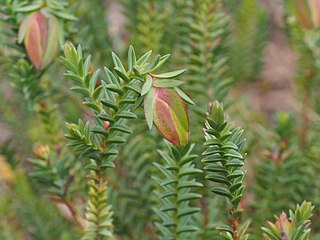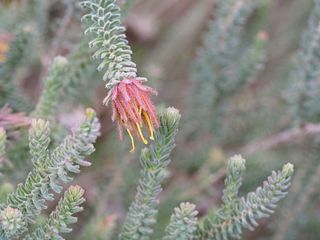
Darwinia, sometimes commonly known as mountain bells or simply bells, is a genus of about 70 species of evergreen shrubs in the family Myrtaceae, endemic to southeastern and southwestern Australia. The majority are native to southern Western Australia, but a few species occur in South Australia, New South Wales and Victoria. The genus was named in honour of Erasmus Darwin, grandfather of Charles Darwin by Edward Rudge in 1816. Most darwinias grow to a height of between 0.2 and 3 m, and many are prostrate shrubs. Most have small, simple leaves and the flowers are often grouped together, each flower with five red, white or greenish petals and ten stamens. In many species, the flowers are surrounded by large, colourful bracts, giving rise to their common names.

Darwinia citriodora, commonly known as lemon-scented darwinia or lemon scented myrtle, is a plant in the myrtle family Myrtaceae and is endemic to the south-west of Western Australia. It is a shrub with oblong to lance-shaped leaves and red, yellow and orange flowers over an extended period. It is a hardy plant in well-drained soil, is often cultivated and used as a rootstock for less hardy species.
Verticordia verticordina is a flowering plant in the myrtle family, Myrtaceae and is endemic to a small area near the coast of the south-west of Western Australia. It is a small, low-growing shrub with crowded leaves and in spring, scattered pale greenish-cream and golden brown flowers. Its unusual flowers and fleshy leaves give the plant a superficial resemblance to a Darwinia.

Verticordia galeata is a flowering plant in the myrtle family, Myrtaceae and is endemic to the south-west of Western Australia. It is a woody shrub with thin, pointed cylinder-shaped leaves and heads of bright yellow flowers on the ends of the branches in spring.

Darwinia fascicularis is shrub in the myrtle family and is endemic to areas near Sydney. A small shrub with aromatic foliage and white flowers, turning red as they mature. Nectar feeding birds are attracted to its flowers as a food source.

Darwinia collina, commonly known as the yellow mountain bell, is a plant in the myrtle family Myrtaceae. It grows as an erect shrub 0.3–1.2 metres (1–4 ft) high with crowded elliptical leaves and bright yellow flower-like inflorescences. It is endemic to a few small areas in the Stirling Range National Park, Western Australia and as a result is classified as an endangered species.

Darwinia oxylepis, commonly known as Gillham's bell, is a plant in the myrtle family Myrtaceae. It grows as a dense, upright shrub 1.0–1.5 m (3.3–4.9 ft) high, and produces large numbers of red inflorescences prominently displayed on the ends of the branchlets in spring. It is one of a group of Darwinias including D. leiostyla, D. macrostegia, D. meeboldii, D. collina and D. squarrosa collectively known as mountain bells. The species is found in only a few seasonally moist gullies near the lower slopes of the Stirling Range National Park and nearby Porongurup National Park and is therefore classified as endangered.
Eremaea × phoenicea is a plant in the myrtle family, Myrtaceae and is endemic to the south-west of Western Australia. It is thought to be a stabilised hybrid between two subspecies of Eremaea. It is an erect to spreading shrub with pointed, elliptic leaves and small groups of flowers, a shade of pink to red, on the ends of the branches.

Verticordia humilis, commonly known as small featherflower, is a flowering plant in the myrtle family, Myrtaceae and is endemic to the south-west of Western Australia. It is a small shrub with leafy branches and scattered, mostly red flowers hanging loosely near the ends of the branches.
Verticordia lehmannii is a flowering plant in the myrtle family, Myrtaceae and is endemic to the south-west of Western Australia. It is slender shrub with only a few branches, well-spaced, oppositely arranged leaves and small heads of pale pink to silvery flowers with a dark pink centre.

Darwinia camptostylis is a plant in the myrtle family Myrtaceae and is endemic to New South Wales and Victoria. It is small shrub with flattened, glabrous leaves and small clusters of green to yellow flowers. There are scattered populations in coastal areas where the plants grow in heath.

Darwinia capitellata is a plant in the myrtle family Myrtaceae and is endemic to the south-west of Western Australia. It is a bushy, many-branched shrub, very similar to Darwinia diosmoides but differs in the arrangement of its flowers, its more branched habit, prominent oil glands on the younger stems and its thinner, paper-like bracteoles. It was first discovered as a separate species when specimens of it were found to have a larger chromosome number than specimens of D. diosmoides.

Darwinia carnea, commonly known as Mogumber bell or Narrogin bell is a plant in the myrtle family Myrtaceae and is endemic to the south-west of Western Australia. It is a small shrub with narrow, keeled leaves and flowers in groups of about eight, surrounded by yellowish-green to pinkish-red bracteoles. It occurs in small, isolated populations near the towns which contribute to its common names. It is the only "bell-flowered" Darwinia to not grow in the Stirling Range National Park.

Darwinia chapmaniana, commonly known as Chapman's bell or Eganu bell, is a plant in the myrtle family Myrtaceae, and is endemic to the south-west of Western Australia. It is a low, rounded, spreading shrub with greyish, hairy leaves and flowers in heads of about 14 small, tubular flowers. The heads are surrounded by long, reddish-yellow, hairy bracts.

Darwinia wittwerorum, commonly known as Wittwer's darwinia, is a plant in the myrtle family Myrtaceae and is endemic to a small area in Western Australia. An erect, spindly shrub with fine leaves and hanging groups of flowers surrounded by leaf-like bracts, it is one of the darwinias known as mountain bells.

Darwinia acerosa, commonly known as the fine-leaved darwinia, is a plant in the myrtle family Myrtaceae and is endemic to a small area in south-west of Western Australia. It is a densely branched, heath-like shrub with crowded, finely pointed leaves and drooping heads of forty to fifty yellowish-green flowers.
Darwinia ferricola, commonly known as the Scott River darwinia, is a plant in the myrtle family Myrtaceae and is endemic to a small area in Western Australia. It is a rounded, densely branched shrub with crowded, linear leaves mostly only on younger branches. The flowers are greenish-yellow and red, and arranged in groups on the ends of the branches, with a long white or reddish style protruding from the petal tube.

Darwinia foetida, commonly known as Muchea bell, is a plant in the myrtle family Myrtaceae, and is endemic to Western Australia. It is a small upright shrub with greenish coloured nodding flowers at the apex of the stems, that have an unpleasant odour. This is a very restricted species, known from only a couple of locations.
Darwinia terricola, commonly known as the Blackwood bell, is a plant in the myrtle family Myrtaceae and is endemic to a small area in the south-west of Western Australia. It is a small, low, sometimes prostrate shrub with small, linear leaves and small groups of flowers surrounded by reddish-green bracts and which usually lie on the ground.

Darwinia whicherensis, commonly known as the Abba bell, is a plant in the myrtle family Myrtaceae and is endemic to the south-west of Western Australia. It is a small shrub with linear leaves and bell-shaped, flower-like inflorescences containing more than twenty flowers surrounded by bracts, the largest of which are red with green edges.
















